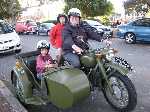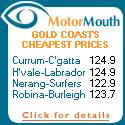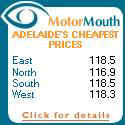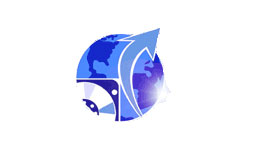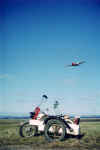The 1946 Dusting sidecar
My introduction to Three Wheels
The 1946 Dusting sidecar.
During a trip to Pratt & Osborne in Geelong on the Yamaha YDS3 in 1968 I asked about fitting a sidecar and I was told that the Dusting was the best sidecar ever made and if I brought my bike back next Saturday I could have a 1946 Dusting sidecar chassis fitted to it. They only had a chassis and I would have to arrange a body for myself. The week dragged by very slowly and next Saturday finally arrived and I hurried down to Geelong. The mountings were fabricated and the sidecar was fitted and aligned and I was taught the importance of always keeping any sidecar correctly aligned and how to go about that science. The guy who fitted it was named "Mac" or "Macca" I think, but I am not sure after all these years. We shall call him "Mac" for now until somebody with a better memory than mine corrects me. Anyway he very wisely drove me down to the Eastern Gardens where "there's nothing to run into if you don't get the hang of it."
How to ride a sidecar outfit
You see, when you are driving a sidecar outfit, the process of steering it is a totally different matter to the process of steering a regular solo motorbike. On the solo machine, you just lean it into the corner and around you go. But scientifically speaking, how exactly do you lean it into the corner? Well, believe it or not, if you are going to take a corner to the right, you actually begin that corner by steering to the left. As you turn the front wheel to the left, the bike begins to fall over to the right ... after all, there is nothing to hold it up. As it begins to fall, the forward motion is causing it to want to stand up again. These two forces balance each other out and the bike kind of "falls around in a curve". Now look what happens if you add a sidecar to the same bike. All of the controls are the same. The motor gearbox and clutch are all the same. But the steering ... Sheesh!!! Let me describe briefly my first attempt to ride in the Eastern Gardens. I let the clutch out and the bike started moving. The path turned gently to the right. Now with some 60,000 miles or thereabouts of riding experience I reckoned I knew pretty well how to turn a motorbike around a very gentle right hand curve. But suddenly I discovered that this outfit seemed to have a mind of its own! I crossed the lawn on the left and then through the flower beds and then had the sense to pull the clutch in and hit the brakes just in time to avoid mowing down a row of standard roses. By this time Mac was killing himself laughing at the expression on my face. I felt more like Mulga Bill! We pushed the outfit back onto the path. Then Mac explained to me the difference between riding a solo and a sidecar. The sidecar outfit is so obedient that it goes exactly where you point it. When I had wanted to turn right, I had naturally begun the turn by turning the handlebar slightly to the left. The outfit, obeyed me by going exactly where I had pointed it straight across the lawn and the flower beds! Mac explained to me that I had to overcome my natural inclination to turn the other way and to very deliberately turn the handlebars towards where I wanted the outfit to go. Somehow it made sense to me and I took all the turns correctly from then on. After a bit more practice we went back to Pratt & Osborne and dropped off Mac while I headed back to Buninyong. Norm and Allan Osborne both came out to see me off. Norm advised me that if I learned to ride on the road with just the chassis for a while before I fitted a body to it, then I should have no real problems after I fitted the body. He also recommended that I get out into a paddock and practise lifting the sidecar up into the air by turning sharply left and then to control the machine as a strangely unbalanced solo so that I would know what it felt like when the sidecar was approaching lifting point.
Chair in the air ... and over she goes!
The trip to Buninyong was relatively uneventful. A couple of times I momentarily forgot I had a sidecar and felt most uncomfortable for a second or two as I started to drift in the wrong direction. Then I would remember the sidecar and simply turn where I wanted to go and, surprise, surprise! it went exactly where I pointed it. However, as I deliberately kept my speed down low, I had no disasters. In fact as I arrived in Buninyong, I felt pretty pleased with myself that I had so quickly mastered this business of riding a sidecar. At that time I lived in Scott Street Buninyong which was a gravel road. The left turn into Scott Street had a steep adverse camber. I arrived at that corner without incident and turned left. Suddenly I felt decidedly uncomfortable and then suddenly lost it. Next moment I discovered myself lyng in the ditch with the motorbike on its side and the sidecar sticking uselessly up in the air, its wheel still spinning freely! I suddenly realised that perhaps I had not yet really mastered this skill at all. I pushed it back up onto the road and slowly and carefully rode the final 50 metres home.
That weekend I took the sidecar out several times and got more used to riding it. By Monday when it was time to ride it to Ballarat Teachers' College where I was then a student, I strapped my backpack onto the sidecar chassis and had no problem at all getting there.
The following weekend was the scheduled Stunt Team practice day out at the old airport. So I went out there on my sidecar and out in the paddock I followed Norm Osborne's advice and practiced lifting the sidecar. Before long I found I was able to do tight figure-eights on two wheels with the sidecar in the air all the way. I think a few weekends of practice like that really helped me to become a far more proficient sidecar rider.
The "Yellow Coffin"
The first body I had on the Yamaha outfit was a long yellow steel and particle-board "coffin" which was over two metres long so that it could be slept in (which I never did) and it was about 60 cm high and 60 cm wide. It was built by my dad and was so incredibly heavy that the "sidecar drove the bike" in that acceleration caused the bike to want to drive around the sidecar while deceleration caused the sidecar to want to continue on and circle around the bike. There must have been some bright yellow paint left over from some other project as it was painted a bright yellow all over. It had the cushions from a bucket seat that had originally been in some car. It took various members of the family around a few times and once took a well-known television personality on a tour of the Strzelecki Ranges. I didn't like it much as it caused excessive fuel consumption and slowed me down too much. I used it for a couple of camping trips, but otherwise I preferred to lift the body off and drive around with just the chassis.
Somewhere in my travels, very soon after deciding that the yellow coffin was too heavy,
I found an abandoned wooden fish box. It was about 20 cm deep by about 45 cm
wide by about 1.1 metres long and was made of good, strong, solid but light weight, pine
wood. It cost me nothing except the price of four coach bolts from the nearest
hardware store which I used to mount it on the Dusting chassis. That box hung
around for years. It was a requirement in those days that all motorbikes needed to
display a front number plate. In the photo at the right it was still on the front
mudguard. However, to allow for better cooling I eventually moved my number plate
from the front mudguard to the front of the Fish Box. It had many different number
plates screwed onto that box over many years as it became the workhorse sidecar body that
was fitted to a succession of Dusting, Harley, Watsonian, DJP and Tilbrook sidecar
chassis. 
That old fish box was great for camping; great for lugging almost anything anywhere.
At some stage over the years, someone was painting their front fence white and I
hopped in to lend a hand. When we had finished painting the fence, my friend said,
"Why don't we paint your sidecar; its looked drab and dirty for Donkey's years."
So we undid the four coach bolts and the number plate screws and went ahead and
painted it a brilliant white. When the paint had dried, we mounted it back on the
chassis, and that white fish box became well known around Gippsland for many years.
Fairly early on in the fish box era, my father commented that if it had a lockable
toolbox, I could keep extra tools in it. My brother Mick was a carpenter and joiner
so in no time he had knocked up a solid wooden tool box and we used steel shelf brackets
to mount it to the front of the fish box. A hasp and staple meant that a padlock
could be used to lock it and, over a great many years, any time I carried anything I
didn't want stolen, it was thrown in that toolbox. The bike's front number plate was
then usually screwed to the front of the toolbox.
Now a sidecar is a very useful item for carting things around in, but the law requires that if the things you cart around happen to be people, then you are required to provide a proper seat for them. The first seat for the fish box was an abandoned shiny red-upholstered chrome-plated kitchen chair that had a bent leg. It only took a few moments with a hacksaw to remove all four legs and the fish box had a seat. The kitchen chair can be plainly seen in the photograph with the aeroplane above.
Eventually the kitchen chair seat was rusting and the upholstery was starting to go, so we found an abandoned Toyota Commuter folding auxilliary bus seat which we screwed to the floor of the fish box and which folded down to almost nothing when it was not in use. My passengers all reported that the Toyota seat also was a very comfortable way to travel in the sidecar. I wouldn't mind finding one of those Toyota seats today, as it would fit very nicely screwed to the inside of the boot lid of my Chang Jiang sidecar.
Now if that old fish box could talk it could tell of all sorts of crazy people who rode around on its chrome and red seat and some of the even stranger loads that it carried over the years. Many a time I picked up hitch-hikers and people whose motorbike or car had broken down and needed a lift to a town to purchase spares or petrol. I remember one fellow whose truck had broken down on a remote mountain road. I stopped to offer him a ride and he asked me whether it was safe to ride in such a small sidecar. As he had been waiting two or three hours and I was the first vehicle, I asked him whether he wanted to wait for the next car. He decided to come along in the fish box and after a somewhat apprehensive first 100 metres, I noticed he had a huge smile on his face. After 50 miles or so, when we reached a settlement where there was a motor garage, he told me he hadn't had so much fun since he was a kid and he badly wanted to own a sidecar for himself!
And if that old fish box could talk it would talk of this silly young owner who had dragged it alongside of a multitude of miscellaneous motorcycles. It ran along proudly beside Yamaha twins and singles of various vintages, a Triumph, several Harleys dating from 1925 to 1936, a Suzuki or two, A Moto Guzzi and a plethora of Hondas all the way up to a Gold Wing. It could talk of Kangaroo Rallies, Southern Cross Rallies, Alpine Rallies, and other motorbike rallies from the Warrumbungle Ranges to the Flinders Ranges. It could talk of lots of broken down motorbikes that were carted home in it (the seats were instantly removable). It could talk of bringing home a number of other sidecars that were gathered from all parts of the state in various different years. One of these was a Dusting Vauxhall Deluxe body which was in fairly delapidated condition but last time I heard about it, it had been fully restored and was going to rallies fitted to an Indian.
A "brand new" 1946 Dusting body to match the sidecar
 The photograph at the right shows the "new" 1946 Dusting sidecar
shortly after it was fitted to my Yamaha YDS3. There are three motorcycles in the
picture: The Yamaha-Dusting outfit is in the foreground, the next bike with the leather
panniers is my brother Mick's BMW, and next to that is my sister's 305cc Honda Dream over
against the wall. A second Dusting sidecar chassis can just be seen beside the
shed in the background on the right. Picture was taken in the back yard of
our family home at 256 Commercial Road, Morwell.
The photograph at the right shows the "new" 1946 Dusting sidecar
shortly after it was fitted to my Yamaha YDS3. There are three motorcycles in the
picture: The Yamaha-Dusting outfit is in the foreground, the next bike with the leather
panniers is my brother Mick's BMW, and next to that is my sister's 305cc Honda Dream over
against the wall. A second Dusting sidecar chassis can just be seen beside the
shed in the background on the right. Picture was taken in the back yard of
our family home at 256 Commercial Road, Morwell.

 The colour photographs at right
show the same Dusting body after it was repainted to match my Triumph Trophy, but at the
time the photos were taken, the Triumph was away having the engine repaired. The
little step-through was not really attached to it although the photo makes it look like
the most underpowered sidecar outfit you ever saw. My sister Karen is seated on the
step-through; my brother David is looking out through the back door.
The colour photographs at right
show the same Dusting body after it was repainted to match my Triumph Trophy, but at the
time the photos were taken, the Triumph was away having the engine repaired. The
little step-through was not really attached to it although the photo makes it look like
the most underpowered sidecar outfit you ever saw. My sister Karen is seated on the
step-through; my brother David is looking out through the back door.
One day an old sidecar rider from yesteryear approached me in the main street of Morwell and said, "That's a Dusting sidecar you have there, isn't it?" When I agreed he continued, "Well back in 1946, I bought a brand new Dusting Tourer and lifted the body off it and fitted a fish box in its place so I could do my deliveries. I sold the outfit after the war, but the original Dusting body is still up in the loft in my shed. Would you like to buy it for fifteen quid?" Immediately all other things planned for that day were cancelled and I followed him to his home where I duly purchased the sidecar body. The body was in excellent condition: excellent upholstery, excellent woodwork, excellent steel body. It was black with white pin-striping. Like the fish box, it needed only four new coach bolts to mount it to the chassis. Also like the fish box, it was used with a multitude of motorcycles. I eventually sold it in about 1974 or '75 attached to a fully restored 1936 1300 cc side-valve Harley. During the years I owned the Dusting body it alternated with the Fish Box: The Dusting was used when I wanted a "real" sidecar and the Fish box was used when I wasn't expecting to carry people but was likely to be lugging around all manner of other items or where the sidecar stood a chance of being knocked around.
NOTE: If you know of any links which you think should be added to this page, or if you find that some of the links on this page do not work, or if links now lead to unsuitable content, please email me at phil DOT drdisk AT gmail DOT com to advise me of the details.
This page was last updated on 07/02/08 at 07:14:39 Hong Kong Time.
2007-01-10
You are visitor number (total hits to all pages in this web-site) since 24th June
1997.
Copyright © 1996 - 2010 Phil Smith, all rights reserved. All contents in this web site are provided as is without warranty of any kind. Phil Smith expressly disclaims any liability from the use of any information in this web site.
Note: for sections of some of the pages within this site attributed to [HKO]: the links and materials provided therein are supplied by the Hong Kong Observatory and the following Notice is applicable to those sections: Copyright Notice: All weather information shown here, including but not limited to all text, graphics, drawings, diagrams, photographs and compilation of data or other materials are provided by the Hong Kong Observatory. Any reproduction, adaptation, distribution, dissemination or making available of such copyright works to the public is strictly prohibited unless prior written authorization is obtained from the Hong Kong Observatory.
Note that the e-mail address for Phil Smith (also known as "Doctor Disk") has been changed to phil DOT drdisk AT gmail DOT com with effect from 18th March 2006. To use this e-mail address, in your e-mail program's "To" field, type out the words in blue replacing " AT " with "@" and replacing " DOT " with "." so that there are no spaces. Sorry for the inconvenience, but my junk mail had passed 1,000 items per day.
 |
